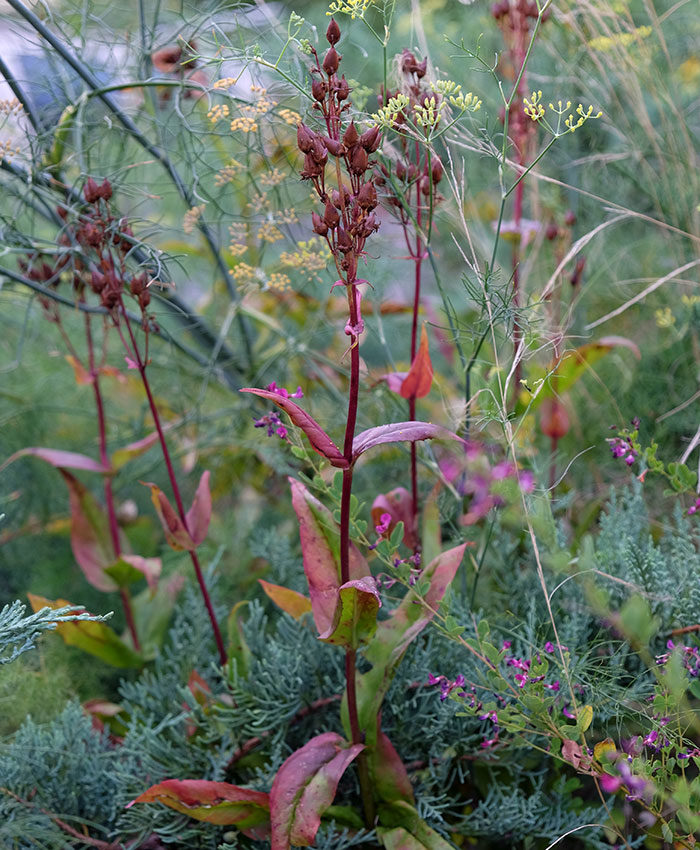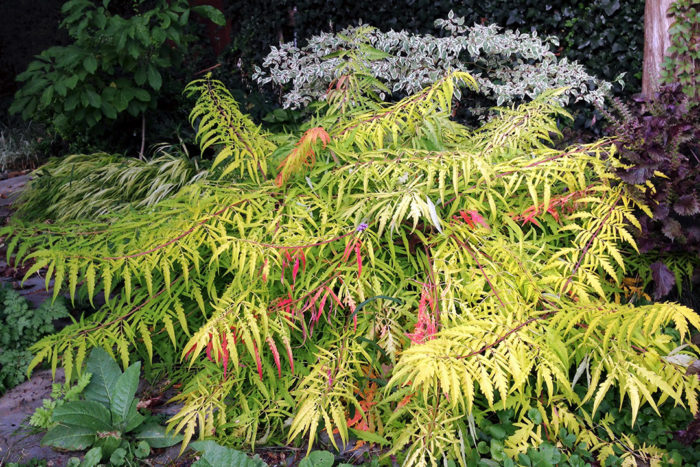
The Northeast’s reputation for extraordinary fall color is well established. We locals are so lucky! We don’t have to travel far to view calico-patterned landscapes of deciduous trees, shrubs, and vines turning leaf by leaf. And when we choose plants based (at least in part) on their fall display, our own gardens will be worthy of a stop on the tour too.
Beardtongue (Penstemon digitalis, Zones 3–8) is a full-sun-loving and drought-tolerant native wildflower whose plain green leaves, stems, and seed heads start turning blood red at the end of summer. Did you already deadhead them this year? Next year, after early summer’s 2- to 3-foot spires of pink flowers fade, leave stems standing to allow knobby seed heads to form. Beardtongue self-sows, but spring’s crop of seedlings will be easy to identify and edit.

Unlike the potted mums (Chrysanthemum spp. and cvs., Zones 4–9) decorating every front porch in fall, old-fashioned Korean mums like ‘Hillside Sheffield Pink’ (Chrysanthemum ‘Hillside Sheffield Pink’, Zones 5–9) are keepers best planted in full sun and average to moist soil. Graceful 1- to 3-foot tall banks of dusty pink daisies are the perfect foil for the deep purple-reds, oranges, and yellows of fall. Clumps spread via rhizomes and are easily divided and redistributed in spring. (They’re a classic pass-along plant.) Give stems the Chelsea chop a couple of times before the end of June to reduce their tendency to splay sideways.

Tiger Eyes® staghorn sumac (Rhus typhina ‘Bailtiger’, Zones 4–8) is a glowing focal point in spring, summer, and fall. Full sun brings out the yellow in its finely cut pinnate foliage, but partial shade mellows the yellow to chartreuse and grants the foliage extended time to blaze neon orange in early fall before dropping to expose furred antlers. Tiger Eyes® is a generously suckering shrub (friends will want your edits) that thrives in medium to dry soil and grows 3 to 6 feet tall and wide.

‘Blue Mist’ dwarf fothergilla (Fothergilla gardenii ‘Blue Mist’, Zones 5–8), with its quilted oval foliage the color of faded denim, would be a perfect complement to Tiger Eyes® staghorn sumac if only they shared the same cultural preferences. But this witch hazel relative prefers more soil moisture, and full sun improves its color and spring display of prefoliage bee-magnet bottlebrush flowers. Eventually—almost later than anything else—fothergilla’s color shifts from glaucous blue through a mesmerizing kaleidoscope of yellow, orange, red, and purple before dropping. ‘Blue Mist’ grows slowly to about 3 feet tall and wide.
Our local tourist bureaus tend to promote only the exact moment of fall’s peak color, but it’s a long season. With the right plants and our eyes on the garden’s details, we gardeners can stretch the show from summer’s end right up to winter’s doorstep.
—Kristin Green is the author of Plantiful: Start Small, Grow Big With 150 Plants That Spread, Self-sow, and Overwinter. She gardens in Bristol, Rhode Island.


















Comments
Log in or create an account to post a comment.
Sign up Log in